Lag is easily one of the most-difficult concepts for amateur golfers to understand. Not only do most players not understand how to create lag in their swings, they don't even understand why they should worry about it in the first place. The average golfer thinks they just need to swing their arms down into the ball as fast as possible in order to create long drives and powerful iron shots. Unfortunately, it isn't that simple. If you hope to add significant distance to your shots and increase your swing speed effectively, you will need to maximize the efficiency of your swing. That means ensuring that the fastest point in your swing is right at the bottom – and that means learning how to use lag correctly.
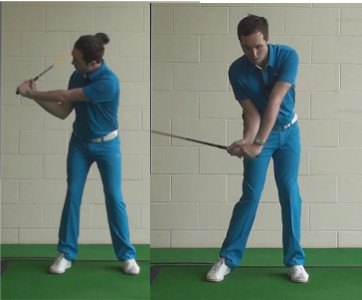
It is important to hold your lag in the downswing because it is the only way to maximize the power in your golf swing. Many golfers chase extra yards by working on their fitness or changing things like stance and grip, but it really comes down to the lag you are able to maintain coming into the ball. If you waste your lag early in the downswing, you will never live up to your distance potential – however, if you can learn how to manage that angle correctly prior to impact, you could start to launch the ball farther than ever before.
If you want to get into a long, technical discussion about the golf swing, bring up the topic of lag. It seems that every golfer and golf instructor has an opinion on this topic, and they don’t always match up with one another. In this article, we will aim to simplify the discussion on this topic and provide you with some actionable steps that you can use to play better golf.
Before we go any further, it is important to state that this is an important topic which deserves your attention. If you are serious about getting better at this game, you will need to understand what lag is and why it matters. Whether or not you actually need to work on this part of your game is yet to be seen but improving your understanding of the topic is a great place to start.
All of the content below is based on a right-handed golfer. If you happen to play left-handed, please take a moment to reverse the directions as necessary.
— What is Lag?
Before we can attempt to help you analyze your own swing, the first step in this process is to clearly explain what lag is and why it is important. This can be a little tricky to understand at first, so read through these points carefully – and consider re-reading them a couple of times until you have a clear picture in your mind.
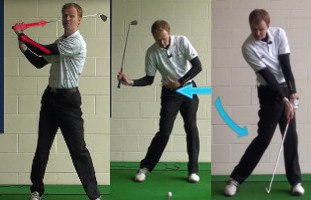
- A relationship between the club and your body. When a golfer talks about ‘lagging’ the club, he or she is talking about allowing the club to lag behind the body in the downswing. Rather than bringing the club down directly in front of the chest, in a similar manner to which it went back, the player is going to turn their body aggressively toward the target and let the club hang back. When done correctly, that lag can help the golfer build a tremendous amount of speed in the downswing. The delay between the body and the club will open up the possibility for speed to develop as the club catches up nearing impact. If you were to strictly keep the club directly in front of you as you turn back and through, it would be nearly impossible to hit the ball hard. You might be able to hit the ball solidly this way, and you could probably do a good job of keeping it on target, but you’d lack the speed needed to send the ball way out into the distance.
| GOLF FIXES BY PGA PROS |
|---|
| Keeping Relaxed And The Right Mindset To Create Golf Driver Lag | Video | Article |
| The Problems With Trying To Create Lag With The Golf Driver | Video | Article |
| Cure 3 – Hold Your Golf Swing Lag | Video | Article |
| How The Impact Bag Can Improve Lag In The Downswing | Video | Article |
| Women's Golf Fix – Relationship Between Lag And Release | Video | Article |
| To Much Swing Lag Causes Loft Issues | Video | Article |
| Keeping Relaxed And The Right Mindset To Create Golf Driver Lag | Video | Article |
| Cure 3 – Hold Your Golf Swing Lag | Video | Article |
| LESSONS |
|---|
| The Mysterious Lag In The Golf Swing | Video | Article |
| The Power Of The Lag In The Golf Swing | Video | Article |
| Lag It Like A Pro In The Downswing | Video | Article |
| Trusting The Feeling Of Lag During The Swing | Video | Article |
| Create Lag In The Golf Swing | Video | Article |
| What Creating Lag With The Golf Driver Means | Video | Article |
| Golf Pro Webb Simpson: Powerful Downswing Lag | Video | Article |
| Hingeing The Wrist To Create Lag In The Golf Down Swing | Video | Article |
| Holding The Golf Lag Angle And Softening The Hands | Video | Article |
| What Lag Looks Like During The Golf Swing | Video | Article |
| Why Create Lag In The Golf Swing | Video | Article |
| Learning How To Get The Feeling Of Lag During The Golf Swing | Video | Article |
| Creating More Golf Driver Lag Should Improve Distance | Video | Article |
| How to Create Lag with my Golf Driver | Video | Article |
| The Basics Of Creating Golf Lag With The Driver | Video | Article |
| Lag The Secret Move In The Golf Swing | Video | Article |
| How to Create Lag with my Golf Driver | Video | Article |
| The Basics Of Creating Golf Lag With The Driver | Video | Article |
| Lag The Secret Move In The Golf Swing | Video | Article |
| The Mysterious Lag In The Golf Swing | Video | Article |
| The Power Of The Lag In The Golf Swing | Video | Article |
| The Problems With Trying To Create Lag With The Golf Driver | Video | Article |
| Lag It Like A Pro In The Downswing | Video | Article |
| Trusting The Feeling Of Lag During The Swing | Video | Article |
| Create Lag In The Golf Swing | Video | Article |
| What Creating Lag With The Golf Driver Means | Video | Article |
| What Is Lag In The Golf Swing – Senior Golf Tip | Video | Article |
| What Role Does Lag Have To Improve Golf Iron Strikes | Video | Article |
| PRACTICE DRILLS |
|---|
| How to Create more golf club head lag with this simple drill | Video | Article |
| Lag Drill | Video | Article |
| Lag Pump Drill | Video | Article |
| The Only Lag Drill You Will Need | Video | Article |
| Understanding The Concept Of Lag In A Golf Swing | Video | Article |
| What is good distance control golf putting drill 2 Lag to an endzone | Video | Article |
| How to Create more golf club head lag with this simple drill | Video | Article |
| Controlling Your Golf Lag Putts Drill | Video | Article |
| Lag Drill | Video | Article |
| Lag Pump Drill | Video | Article |
| The Only Lag Drill You Will Need | Video | Article |
| Understanding The Concept Of Lag In A Golf Swing | Video | Article |
| GOLF QUESTIONS |
|---|
| What Is Lag During My Golf Driver Swing And Why Is It Useful | Video | Article |
| How Can I Create More Lag In My Golf Swing? | Video | Article |
| Whats the best way to improve my lag putting? | Video | Article |
| Should I Lag My Long Golf Putts Or Should I Try To Hole Them | Video | Article |
- A whip-like effect. One helpful way to think about lag is to picture a whip. This isn’t a perfect analogy, but it is the same general idea. As you swing down, you turn your body toward the target to gradually build up speed while the club hangs back. Then, as impact approaches, your body turn starts to slow and the club whips down into the ball with authority. The successful execution of this move is why professional golfers are able to hit the ball so far with what looks like a smooth, easy swing. They are whipping the club into the ball at the last moment, using their body rotation to set the stage for a powerful impact. You may not get to the point of hitting the ball as hard as the pros, but you can make some progress and add a few yards to your driving distance as a result.
- Finding a balance with your hands and wrists. Perhaps the trickiest part of the entire lag discussion is figuring out how much to allow your hands and wrists to be involved in the golf swing. Letting your hands do a lot of work at the top of the swing and into the downswing can open up the potential for added power, but many golfers will find that they sacrifice control in the process. So, how do you figure out how much hand and wrist action you can get away within your swing without completely losing control of the ball? It’s a tricky balance, to be sure. Some players are able to control their shots while lagging the club aggressively with their hands, while others play better when they keep their hands out of it as much as possible. As is so often the case in golf, you’ll have to experiment with different techniques in order to find what works for you. It is sometimes true that smaller golfers need to use their hands more in order to build speed, while taller players can make a big shoulder turn and use that rotation to create their power. However, that’s just a general rule of thumb and may not apply to every player.
- Unwinding into the ball. At some point in the downswing, the potential energy stored up in the lag that you have created will need to be put to use in order to strike the golf ball. For some players, unwinding the club and striking the ball feels like an intentional action with the right hand. For others, it is the rotation of the body through the hitting area that seems to do the job. Ultimately, you’ll have to figure out how you are going to utilize your lag to hit powerful shots. The one thing you don’t want to do is hold onto that lag all the way through impact and into the finish. This type of swing is a cut-off motion that never leads to good results. You would hit weak shots that probably leak out to the right if you don’t let the club release and fire through the hitting area.
At this point, you should have a pretty good idea of what it means to lag the club. You still might not know exactly what it should feel like, but you can keep working on that as you get farther into this subject. For now, know that lagging the club means allowing it to trail behind and come through the hitting area after your body has turned through the shot.
Still struggling to grasp this concept? Try this idea – find a swing video online of one of your favorite professional golfers. It doesn’t really matter which golfer you select, as long as the video is shot from the face-on perspective. As you watch the video, pause it a few times during the downswing to compare the position of the golfer’s body to the club. With almost no exceptions, you will find that the club is lagging behind. If you can find a video which is presented in slow-motion, that will give you an even better image of what is going on with regard to lag in the swing. If nothing else, reviewing a video of a professional golfer swinging the club from the face-on perspective should be enough to get this concept to click in your mind.
— Are You Lagging the Club Properly?
Now that the general concept of lag has been laid out, we need to turn out attention to your own golf swing. How are you doing with regard to lag? Before you take a close look at your technique, you can ask yourself some simple questions to get a good idea of how you are faring on this point.
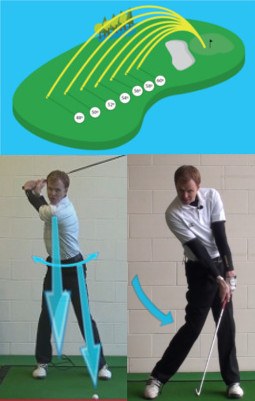
- How far do you hit the ball? If you are easily able to keep up with your playing partners in terms of distance – and sometimes you are even the longest player in your group – you are probably doing pretty well with lag. It’s hard to hit powerful drives without lagging the club at least somewhat successfully. So, if you are already happy with your driving distance, you may not need to look too much more into this topic. The main benefit of improving your lag would be to pick up distance (and you may increase your spin rate, as well, which can be a good or bad thing). If you aren’t in need of extra distance and you have bigger priorities in the game, it might be best to set the subject of lag off to the side while you work to master other parts of your technique.
- How repeatable is your swing? No one hits perfect shots over and over again, but are you relatively happy with the consistency of your ball striking? Those who are able to strike the ball cleanly more often than not might be best to leave their lag alone. If you start ‘messing’ with this part of your technique in search of added power, you may create more problems than you solve. It’s easy to get off track when you mess with how your hands and the club are behaving at the top of the swing, and you certainly don’t want to make yourself worse for no reason. For players who already strike the ball nicely, the best course of action may be to leave well enough alone.
- Do you achieve a downward strike with your irons? Hitting down through the ball with your irons is a good sign that your swing is on the right track. You don’t necessarily want to unearth a massive divot each time you hit the ball, but taking a long, shallow divot is indicative of an aggressive downward hit that will send the ball soaring into the air. If you are happy with the way you hit down into the ball, that is another sign that all might be well with your lag efforts.
If you were nodding along in agreement as you read through those point, you probably don’t have much to worry about in terms of lag. Of course, golfers who hit the ball long, have repeatable swings, and strike down nicely on their irons are few and far between. Most likely, those points didn’t describe what is currently going on in your game, which is why you are here in the first place.
So, how do you figure out if you are doing a good job lagging the club? Simple – apply the same method we talked about in the previous section regarding professional golfers. Ask someone to take a video recording of your swing from the face-on position and watch it back to see how you are doing. With such easy access to great technology these days, you should be able to capture a quick video and watch it in slow motion to check on your lag. If the club isn’t lagging behind as you swing down, you’ll know exactly what you need to work on.
If you are unable to take your own swing video for some reason, it might be worthwhile to head to a golf instructor for help. Most instructors these days have some quality equipment in place at their facility, so they should be able to shoot video of you in action and play it back in slow-motion for a better look. Not only will this approach give you a clear picture of how your swing is behaving in terms of lag, but you will also be able to ask the instructor for any advice he or she may have regarding your swing technique.
— A Couple of Lag Drills
It’s hard to learn how to lag the club. We aren’t going to sugarcoat that fact, because it is true. With that said, using the right drills can help you get a better feel for how the club should behave during the swing. We have outlined two drills below – hopefully at least one of these will prove to be beneficial in your game.
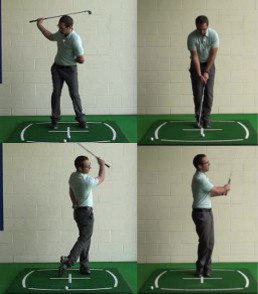
- Right hand pitch shots. In this drill, you are going to hit a few balls down the range using only one hand – your right hand. You won’t hit these shots very far, but that’s okay – you are simply trying to learn what it feels like to hit the ball while using at least a little bit of lag. Also, you are going to learn how much difference lag can make when hitting the golf ball. To get started, find a place to hit on the range and set aside a few golf balls. While you could use just about any club in your bag for this drill, a short iron would be the best choice. Take your regular stance with two hands on the club but remove your left hand before you make a swing and put it in your pocket or behind your back. Then, with just your right hand on the club, make a good shoulder turn and hit the shot to the best of your ability. Most likely, the first shot or two won’t be pretty. Stick with it and try to improve the way you lag the club as you continue. If you start to get a better and better feel for your lag, you’ll soon see how much harder and cleaner you can hit the ball when you do lag the club correctly.
- No lower body. This drill is similar to the first one, except this time you will be using both hands on the club. However, instead of standing with your feet in your normal stance, you’ll put them right next to each other so that your shoes are touching. With such an extremely narrow stance, you won’t be able to use your lower body at all to help the swing pick up speed. That means you’ll have to use your hands and arms effectively, and you’ll need to lag the club if you are going to put any power at all into each shot. Hit a few shots with your feet right next to each other before moving them back out again to make some normal swings. With any luck, those normal swings will have more zip than they did previously, thanks to what you have learned about lag from these two drills.
Give one or both of these drills a try during an upcoming visit to the practice range. Even if you are already in decent shape with your lag, you can benefit from a reminder of what it feels like to lag the club and how it can impact your ball flight.
— The Short Game is a Different Story
Let’s wrap up this article by talking about lag in the short game. Or, more accurately, we are going to talk about how you don’t actually want to lag the club when playing short game shots. Remember how we talked earlier about how lag is largely responsible for helping you pick up speed in your swing? Well, since you don’t need to pick up any speed in order to hit good short game shots, you don’t want to lag the club here. In fact, lagging the club when putting or chipping would only cause problems, so you want to avoid making this move.
Rather than looking for lag, you are going to try to keep the club directly in front of you and move it deliberately in the short game. For example, think about an ideal putting stroke. You don’t want to let the putter drag behind your hands before finally arriving at the ball – you want to rock it with your shoulders so that it stays in front of you and your hands and wrists are taken out of the equation. A lagging putting stroke would be nearly impossible to control, both from a pace and distance perspective.
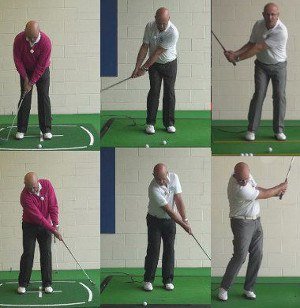
The story is very similar when chipping. While it’s okay -and sometimes advised – to use a bit of wrist action in your chip shots, you still don’t want to be lagging the club in any meaningful way. If you do let the club drag behind, you are likely to hit your shots fat. Your chipping action should be compact, controlled, and repeatable. Do your best to let your big muscles control the chipping action, and only add wrist movement as necessary to elevate the club and hit down through impact.
Believe it or not, one of the drills we used earlier to help you learn lag in the full swing can actually help you learn how not to lag the club when hitting short game shots. During an upcoming visit to the practice putting green, try rolling some putts with just one hand on the putter. To hit solid putts while only using one hand, you are going to have to put the control of the stroke into your big muscles. You’ll need to use your shoulders to rock the putter back and through while you hold your right wrist firm to keep the club under control. If that right wrist gets loose, you’ll never make good contract – and you’ll struggle with both line and speed. Using only your right hand to roll putts is a great drill and one you can return to anytime you feel like your stroke is a bit out of sorts.
In many ways, the short game is the opposite of the long game. When making full swings, you want to hit the ball hard and you want to make an aggressive move down through impact. In the short game, you need to be more careful, trying to precisely hit your line while controlling the distance that the ball travels. It is the need to master both halves of the game that makes golf so challenging, and so addicting. It’s a great idea to pursue improvement in your lag performance with the full swing, just make sure those changes don’t spill over into the short game, where they are unwanted.
We hope you are coming away from this article with a better understanding of the topic of lag than when we started. It can be confusing, to be sure, and it can also be hard to improve your game in this area once you understand how it works. With that said, don’t be afraid to work on this at the range in the hopes of making some meaningful improvements in the weeks and months ahead. Good luck!






